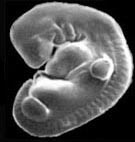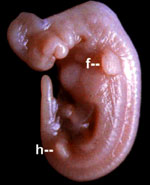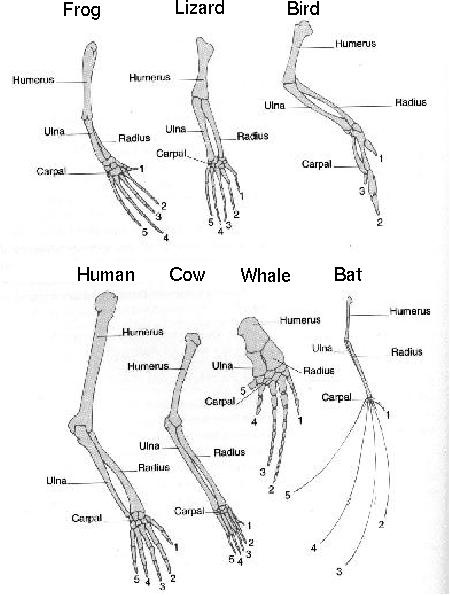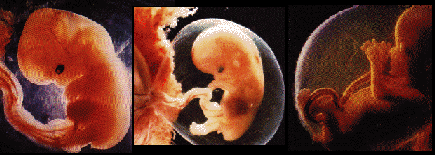Gill Slits
Human

All early vertebrate embryos look like the early fish embryo, they all have pharyngeal pouches. The pouches become gills in fish, and become various structures (eustachian tube, middle ear, tonsils, parathyroid, and thymus) in mammals.
Ear Bones
The middle ear bones of human embryos developed from the same bones that develop into the jaw in reptiles.
Legs and Arms
Dolphin

Lizards and mammals share the common trait of legs. Many snakes and legless lizards develop limb buds in their embryo development, but they are reabsorbed before completing development. Whale embryos have hind legs temporarily appear during their development. The forelimb buds become the fins on whales and become the arms in humans. The image to the right shows the dolphin embryo; f points to the forelimb, and h points to the hind-limb. You can see the similarities between the human, cat, and dolphin embryos. The image below shows the similar structures of the forelimb of humans and other animals.
Tail
Cat

A normal human embryo has developed a tail vertebrae by five weeks of age. This tail is gradually reduced to a small bone composed of just four fused vertebrae which do not protrude the back. The vertebrate becomes a tail in other mammals and reptiles, on whales it becomes the tail and tail fins. This vertebrate can be seen in the embryo images on this page (on cat, human, and dolphin embryos).
Coat of Hair
Ape embryos (which includes humans) grow a thick coat of hair around the same time of development. In humans, the coat appears at about six months. This is called lanugo and it usually sheds at about 8 months into development; premature human babies sometimes still have the lanugo. The other apes do not shed the coat and it becomes their adult coat eventually. Whales also develop the lanugo, and like humans, shed it before birth.
Below is an image comparing the development of several different species.
References
- Biology 336. The University of British Columbia. Lectures on Evolution
- Division of Biological Sciences. University of California, San Diego. Evolution Matters
- Coyne, Jerry A. (2009-01-22). Why Evolution is True. OUP Oxford.
- The TalkOrigins Archive. Evidence for Macroevolution. Talk Origins
•
Antonio Chavez •
antonio_chavez3@my.vcccd.edu •
Moorpark College •
7075 Campus Road, •
Moorpark, CA 93021 •





